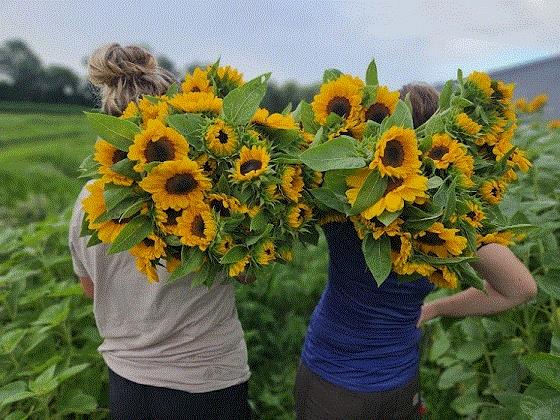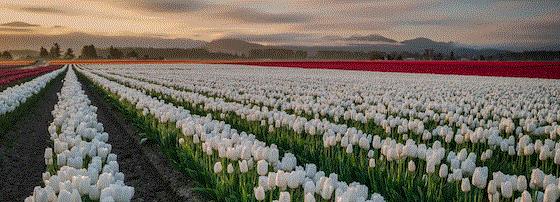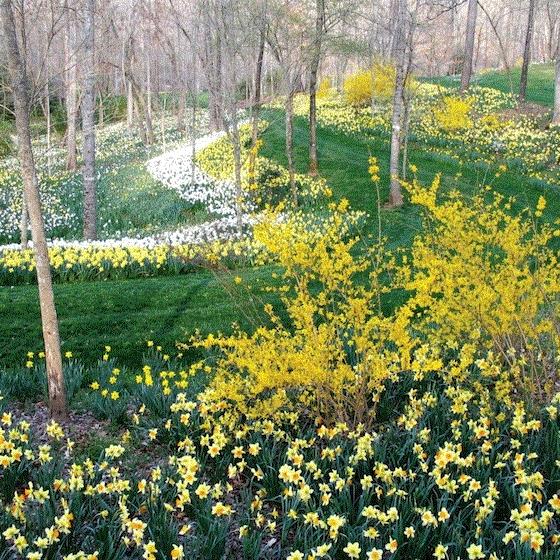BMP's for Greenhouse Sanitation

Every season we start with new plug trays, and in the event we need to recycle trays,
we always rinse them and dip in Zerotol.
Do you have your first succession of cool flowers planted? Before you hurry off and start your next round of seeding, be sure to dip your trays! This is not a place where you want to cut corners! Sanitation is a critical step.
But along with clean trays, you need to clean up your greenhouse. That includes eliminating weeds, sweeping and sterilizing benches, eradicating algae and disinfecting surfaces. There are many scary pathogens such as pythium and thelaviopsis that can live on benches and in soil. Sanitation and disinfecting is key. Here are some pro tips to prevent disease and contamination:
- Disinfect benches, containers and plug trays.
- Keep hands clean or wear gloves when handling plant material. Change gloves periodically.
- Keep hose nozzles off of the greenhouse floor, hang them.
- Keep growing media in a clean area, and cover it.
- Keep unsterilized trays, pots and other containers away from sterile media and surfaces.
- Cover compost bins inside the greenhouse to prevent spread of disease.
Like they say, an ounce of prevention is worth a pound of cure. Do yourself a favor and disinfect your plug trays! It will save you a ton of heartbreak later.
Be sure to check out the full
ARTICLE from the University of Massachusetts Amherst here. It’s a really good read. Also, for more information on cleaning products for your greenhouse, check out this
BULLETIN from Purdue. They even have products listed for organic production systems!

Things to Consider When Hiring Your First Employee

I'm grateful for Team Forget Me Not; the crew is one of the best investments we make each season.
What do you think about when you reflect on last season? It’s exciting when your farm starts to hit its stride. Your customers love your blooms, and demand exceeds supply.
When I think back on last season I remember the abundance, and how I was running around like a chicken with my head cut off cutting flowers as the sun was setting. Sure, I love the hustle, but as we gear up for outdoor flower season, I find myself dreading the reality again.
But the good news is that there is a solution: finding more help! If you find yourself missing important deadlines, struggling to email and communicate with clients, and worse—forgetting to send invoices—it’s time to hire an employee.
Now is a great time to buckle down, write your job description and do some budgeting to see what this could look like. Yes, employees are our biggest expense ... but they are also our greatest asset. I am thrilled that we have some incredibly talented folks on the 2025 Forget Me Not team this season.
If you are on the fence about hiring, I highly encourage you to read this
ARTICLE from the Score Foundation called Step by Step Guide to Hiring Your First Employee. Timing is everything, especially in seasonal business like flower farming. You need enough time to train them so that during peak season they can function on their own. But you also need the cash flow to support this. Below are some points from the article to consider to time your hiring:
-Can you afford to hire right now?
There are more costs than just wages. Think about the cost of interviewing, job listings, insurance and taxes. Will this employee be experienced and be able to generate revenue quickly? If they are inexperienced, their salary will likely dip into your profits until they are trained.
-Is there enough steady work to support an employee?
Do you find yourself (the owner) doing work that is not your peak capacity? Are you struggling to answer emails because you are planting so much? Would your farm improve if you could focus on aspects of the farm that only you can do? Can you keep this new employee busy if you create this new role on your farm?
-Are there other skills needed to run your business effectively?
Are there administrative tasks you can subcontract to open up your time to other tasks? For instance, Tater and I farm out our payroll to a professional company. It costs us less than $50 per week to have someone handle this for us, and it’s a tremendous relief that someone else is filing quarterly reports and making sure withholdings are correct every pay period. This is just one example; there may be some administrative tasks you can hand off that will allow you to work on things that only you can do.
You may also find the following webinar recordings helpful from Score:
You can look at these at your leisure. If you are a seasoned farmer, I encourage you to reach out to a Score mentor. They are free and they even match you with someone in your industry! I met with my new Score mentor last week and it was time well spent.

How to Be a Better Communicator
As many of you know, I love Harvard Business Review (HBR) articles, and this one me in my tracks. It's called
What Great Listeners Actually Do. (Sorry, it's behind a paywall. But you can subscribe!). But here's a summary:
Over the years, I have learned that no one can read my mind. One of my goals this season is to become a better communicator. When you add more staff this is even more critical. This will benefit not only your workplace relationships, but your personal ones, as well.
When I googled “how to be a better communicator,” the top five articles were all about listening. This may sound counterintuitive, but hear me out. The article first identifies what people think good listening entails: not talking when others are speaking, giving the speaker subtle nods and facial expressions to show you are listening, and the ability to repeat what they said almost word for word. According to research on effective listening, these actions are just the tip of the iceberg for effective listening.
HBR analyzed data from 3,492 participants who were enrolled in a personal development program to become better managers. HBR compared the best listeners (top 5%) with average listeners. Below is what they found:
- Effective listening is more than just being silent and nodding: it is not merely a “speaker versus listener interaction,” meaning people value thoughtful and constructive input. You want to be actively engaged in the conversation and ask good questions to help pave the way to a solution.
- Good listening included interactions to build positive self-esteem. Words of encouragement and a safe open environment free from judgement go a long way. Create a safe environment for your speaker. In their research, this did not happen when listeners were silent and disengaged.
- Good listening is seen as a “cooperative conversation.” Remember, the goal is to create an environment where people feel heard.
- Good listeners tended to make suggestions and provide insightful feedback and alternative solutions.
The research concluded that great listeners are like trampolines. “They are someone you can bounce ideas off of … they absorb your ideas and energy, and they amplify and energize and clarify what you are thinking. This allows you to gain energy and height, just like someone jumping on a trampoline.” Hopefully, these ideas help you in your journey to become a better communicator. Effective communication will not only help your farm run more smoothly, it can save you from costly mistakes due to miscommunication.
If you have any additional tips and tricks for how you communicate with your employees, Tater and I would love to hear your experiences. Feel free to drop us a line at
ldaschner@ballpublishing.com.

Must-See Flower Festivals
I know that springtime is not the best time for you to escape your farm to visit a flower festival, but just in case you need a break and can grab a Saturday or a weekend, these are the ten best flower festivals in America, as selected by USA Today's panel of experts and voted on by USA Today readers:
10. Thomasville Rose Show and Festival
Thomasville, Georgia
April 25-26
At this Annual Rose Show, visitors can marvel at breathtaking displays of roses in a multitude of colors and styles. Beyond roses, Orchids on Parade offers a glimpse of orchids thriving in their natural habitat, and the Annual Standard Flower Show showcases a litany of exquisite floral art exhibits. Attendees can enjoy lively parades, live music, family-friendly activities, and food vendors serving Southern delights.
9. Portland Rose Festival
Portland, Oregon
May 25-June 7
With a history spanning over a century, the Portland Rose Festival is a beloved tradition celebrating the city’s namesake flower. Attendees can marvel at the stunning rose displays at the Annual Spring Rose Show, the largest and longest-running rose show in the nation, and enjoy the iconic Grand Floral Parade featuring spectacular all-floral floats. The festival also features the city fair, live music, food vendors, and a variety of family-friendly activities.
8. PHS Philadelphia Flower Show
Philadelphia, Pennsylvania
February 28-March 8, 2026
Hosted by the Pennsylvania Horticultural Society since 1829, the Philadelphia Flower Show is the largest and longest-running horticultural event in the United States. The event features flower and garden displays, horticulture and floral arranging competitions, gardening presentations, and a massive marketplace where more than 150 vendors sell cut flowers, plants, garden tools and floral-themed crafts.

7. Skagit Valley Tulip Festival
Mount Vernon, Washington
April 1-30
During the Skagit Valley Tulip Festival, millions of tulips burst into bloom while local farmers invite visitors to tour their flower farms on foot. It’s one of the state’s biggest events — over a million visitors attend annually.
6. International Cherry Blossom Festival
Macon, Georgia
March 21-30
The International Cherry Blossom Festival in Macon, Georgia, celebrates the arrival of spring, when more than 350,000 Yoshino cherry trees burst into a beautiful display of color. Highlights of this 10-day festival include live music, a Food Truck Frenzy and the guest-favorite Cherry Blossom Parade.
5. Tulip Time
Holland, Michigan
May 2-11
Holland, Michigan, is an apt location for one of America's biggest tulip festivals: Tulip Time. Each year, some 6 million colorful tulips bloom in the city — there are over 200,000 of them in the downtown area alone. In addition to the floral festivities, Tulip Time celebrates Dutch heritage with music, dancing, an artisan market and parades.
4. Rochester Lilac Festival
Rochester, New York
May 9-18
The Rochester Lilac Festival is a free 10-day festival showcasing more than 500 varieties of blooming lilacs in Highland Park, a picturesque park designed by renowned landscape architect Frederick Law Olmsted. Visitors can take guided tours to learn about the park’s rich history and explore the largest collection of lilacs in North America. The festival also offers live music performances, the colorful Lilac Parade, an arts and crafts market and food vendors serving seasonal fare.

3. Mackinac Island Lilac Festival
Mackinac Island, Michigan
June 6-15
The festival began as a way to entice visitors to the island with horse-drawn carriage rides amidst the island’s fragrant flowers. Today, events include the coronation of the Lilac Queen, a 10K run/walk, lilac planting seminars, a cornhole tournament, live music and the popular Grand Parade.
2. Zoo Blooms at Cincinnati Zoo & Botanical Garden
Cincinnati, Ohio
April 1-30
The Cincinnati Zoo & Botanical Garden, one of the few botanical gardens in Ohio, offers one of the largest tulip displays in the Midwest, featuring more than 100,000 tulips. Visitors can stroll amongst more than a million yellow and white daffodils, hyacinths, flowering trees, shrubs and various spring bulbs peeking out from their winter slumber.

1. Daffodil Festival at Gibbs Gardens
Ball Ground, Georgia
Late February through March
Spring begins at Gibbs Gardens as 20-plus million daffodil blooms adorn 50 acres of valleys, hillsides and fields across its 376 acres. Named one of “The World’s 10 Best Places to See Daffodils" by Flower Magazine, Gibbs Gardens offers more than 60 daffodil varieties for six weeks of blooms in shades of yellow, orange, white, peach and deep gold.


Until next time,
Lindsay Daschner (and Tater)
Editor-at-Large—Bloom Beat
Owner—Forget-Me-Not Farms
This email was received by 6,275 of your fellow fresh-cut flower growers!
If you're interested in advertising in Bloom Beat, contact Kim Brown and she will hook you up!